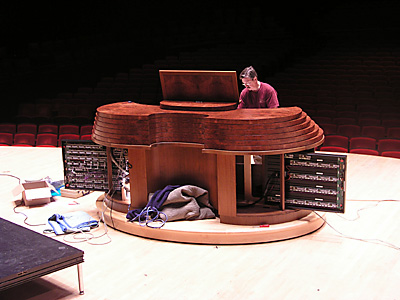 |
|||
 |
Bob Savage Studies show that the average working American will have three to five careers and ten to twelve jobs during his or her lifetime. Bob Savage’s roundabout journey away from Lake City and back again proves that there’s at least one person in our shop who’s an “average working American.” Surrounded here by so many “organ types,” with their bizarre music interests, eccentric hobbies and from-the-cradle certainty about choice of career, Bob stands out by being, well, normal. Bob is a Lake City native, born here in 1954, the son of Pete and Mary Ann Savage. His father owned a small farm and was manager of the local farmers’ cooperative, where his mother also worked as a secretary. His childhood resembled a ’60s family TV show: growing up in a small town with three siblings, building model rockets, playing guitar in a band. Bob attended Lake City schools, and after graduation from high school, enrolled at Iowa State University in Ames to study architecture. Though an architectural degree would have led to a respectable job that would support his wife and future family, Bob’s heart wasn’t in it, and besides, he was overwhelmed by the calculus. When Bob was a young adult, he was not a regular churchgoer, but while at Iowa State he became involved with the Navigators, a Christian collegiate group. After taking a year off to assess his priorities, he enrolled at Lincoln Christian College and Seminary in Lincoln, Illinois. Upon graduation, he served as Director of Christian Education for Minier Christian Church in Minier, Illinois. Although he very much enjoyed working with children and youth, the demands of the position were a source of stress for his young family. After four years and much soul searching, he decided to leave his position in Minier and move back to his hometown in 1985. As it happened, his father’s job situation also changed at this time, and the two decided to open a furniture refinishing and restoration business in Lake City. To make ends meet while the infant business grew, Bob took a position as a custodian in the local school district. When this ended in 1989, Bob applied at Dobson, whose shop was a familiar sight to him on the City Square but about which he knew very little. To his surprise, he was hired that same day. At the time, he didn’t imagine that working here would be anything but a paycheck to tide him over until his “real” business was self-supporting. Like a morning glory vine, organ building has a way of entwining unwitting subjects. Though the Dobson job was, as he saw it, just a fill-in, Bob discovered that he enjoyed the work. But his satisfaction in this work was running up against the growing success of his “real” business, which was drawing customers from up to one hundred miles away. Soon he found he was working two full-time jobs, an untenable stress on him and his family. And so, as in Ames and Minier, Bob found himself at a crossroads. In the end, the challenges of building organs won out over the daily grind of running his own business. Bob especially enjoys the variety of the work he does. From casework to windchests, stop action to swell shades, there is almost no part of the organ that he has not built. A primary responsibility is the construction and leathering of the bellows, which store wind and regulate its pressure. Another important job, especially in larger projects, is the wiring needed for electric stop actions and combination actions. The stage console for the Kimmel Center, shown below, exemplifies the sort of challenge Bob enjoys. All electronic components, some of good size, had to be fitted into the fantastically curving cabinet of the console, and yet be readily accessible for service. Bob devised an elegantly simple arrangement where the major parts slide out like drawers. With his parents and a couple of siblings nearby, Bob has a close relationship with his extended family. He has two sons from his first marriage and gained a second family with his marriage to Patty Riesenberg in 1999. Bob’s well-preserved good looks, favorably compared to Barney Rubble, don’t betray the fact that he’s a grandpa; his eldest son Jason and his wife Lisette welcomed their first child, Eva, in February. There are aspects of our art that, when done well, readily attract favorable attention. An organ’s beautiful woodwork and impressive sound are easily appreciated. However, the same sort of glory doesn’t attach to neat wiring, say, or careful leather skiving, things that are usually hidden from potential admirers deep within the bowels of an organ. A true craftsman relishes the challenges of a project, and takes his chief satisfaction from a job done to the best of his abilities, not from the praise he will receive. Bob is one of those people, a rare soul who enjoys a good challenge, and for whom external validation isn’t necessary. Hmm… perhaps he’s not so average after all. —drawn from The Organbuilder, Fall 2006
|
||
|
Our Shop • Instruments • Recordings • Testimonials Dobson Pipe Organ Builders, Ltd. Site conception by metaglyph All contents ©1999–2016 Dobson Pipe Organ Builders, Ltd. |
|||




